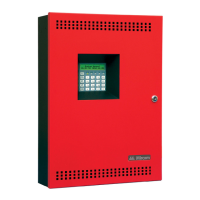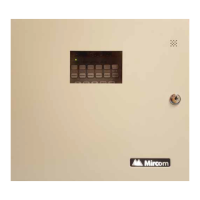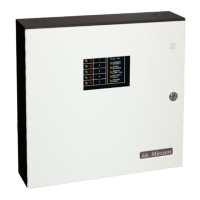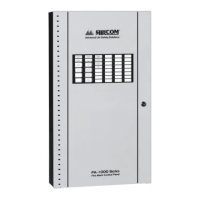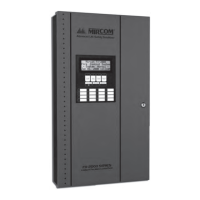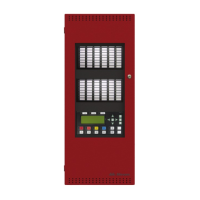43
Indicators, Controls and Operations
If the buzzer is turned on in response to a non-latching trouble or supervisory, it is turned off if
the condition causing it goes away and there is no other reason for it to be on.
9.1.2 A.C. ON LED
The green A.C. ON LED illuminates steadily as long as the main AC power is above minimum
level. The indicator turns off when the level falls below the power fail threshold and the panel is
switched to standby (battery) power.
9.1.3 Alarm LED
The red Alarm LED illuminates whenever the panel detects an alarm condition on any initiating
circuit. Since all alarms are latched until the panel is reset, the LED remains on until then.
9.1.4 Supervisory LED
The amber Supervisory LED turns on steady when there is a supervisory alarm in the Panel
caused by any latching or non-latching supervisory circuit. The LED is turned off when all non-
latching supervisory circuits are restored and there are no active latching supervisory circuits.
Latching supervisory alarms remain active until the Panel is reset.
9.1.5 Trouble LED
The amber Trouble LED flashes at the trouble flash rate when the panel detects any trouble
condition. It turns off when all non-latching troubles are cleared.
9.1.6 CPU FAIL LED
The amber CPU FAIL LED Indicator flashes at the trouble flash rate to indicate a
microprocessor failure on the main board.
9.2 Common Controls
9.2.1 SYSTEM RESET Button
Press the SYSTEM RESET button to reset the Fire Alarm Control Panel and all circuits. In
particular, the SYSTEM RESET button does the following:
• Resets all latching trouble conditions
• Resets all initiating circuits
• Resets the 4-wire smoke supply
• Turns off all indicating circuits
• Turns off signal silence
• Turns off fire drill
• Stops and resets all timers
• Processes inputs as new events
• Does not affect Aux Disconnect

